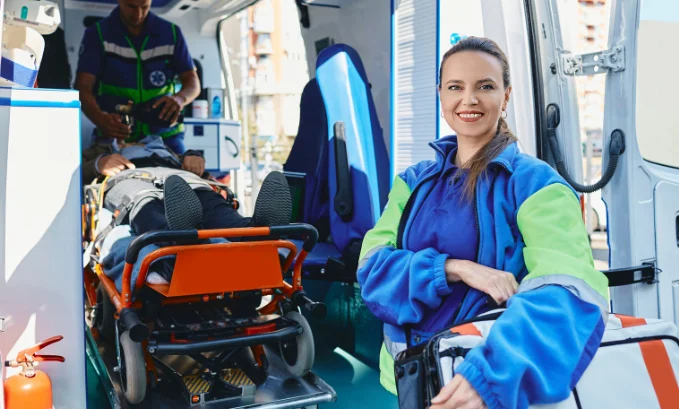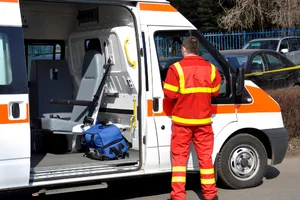Understanding Different Types of Paramedics

Importance of different types of paramedics in emergency medical services (EMS)
Paramedics play an essential role in EMS as they possess specialized skills and knowledge related to pre-hospital advanced life support treatments. These may include administering intravenous fluids, administering medications, performing intubation and other airway management techniques, providing cardiac pacing or defibrillation, using advanced airway devices such as endotracheal tubes, inserting IV lines and catheters, performing minor procedures such as suturing lacerations. Additionally, different types of paramedics can provide high-level patient assessments and the stabilization of medical conditions before the arrival of an ambulance or other transport vehicle.
There are two basic types of paramedics: basic life support (BLS) paramedics and advanced life support (ALS) paramedics. BLS paramedics provide basic medical procedures and treatments in response to an emergency situation. These include administering CPR, performing bandaging and splinting for injuries, monitoring vital signs like heart rate and oxygen levels, providing basic airway management techniques, treating minor wounds, delivering medications like epinephrine autoinjectors for allergic reactions, transporting patients safely to a healthcare facility for further treatment, etc.
ALS paramedics have advanced training that allows them to perform more complex tasks such as providing intravenous therapy (IV), administering medications via injection or inhalation, operating electrocardiograms (ECG) machines to monitor heart rhythm abnormalities, intubating patients whose airways are blocked or compromised due to injury or illness, using sophisticated patient monitoring equipment to assess the severity of a condition or injury before initiating treatment measures, etc.
Event Medical Services (EMS) is a form of paramedic practice specifically tailored to work with events such as festivals or marathons. This type of paramedic must be able to respond quickly in high stress situations while providing proper medical attention at all times. An EMS paramedic team typically consists of both BLS and ALS providers who can assess the situation onsite and determine the best course of action for each individual patient’s needs. They may also provide first aid classes for event attendees prior to the start of the event itself in order to help prevent any potential medical emergencies from taking place during the event itself.
Paramedics in Event Medical Services

Event paramedics play a vital role in providing medical services to large public events, such as concerts, sporting events, and festivals. They are responsible for ensuring the safety and wellbeing of attendees by providing immediate care for any injuries or illnesses that may occur. Event paramedics must be proficient in assessing, diagnosing, and treating a variety of medical conditions, ranging from minor scrapes to life-threatening emergencies.
Event paramedics must possess a wide range of skills to handle the unique challenges of working at large public events. These include excellent communication and interpersonal skills to ensure accurate and timely documentation of patient information; the ability to stay calm and composed under pressure when dealing with chaotic situations; strong organizational capabilities for managing multiple patients efficiently; and knowledge about procedures for providing prehospital emergency care in accordance with local guidelines. In addition, event paramedics must be familiar with the use of specialized equipment such as portable defibrillators.
The importance of these different types of paramedics lies in their ability to respond quickly to medical emergencies at events such as concerts or sporting matches where large numbers of people are present. By providing immediate treatment onsite and stabilizing patients before transporting them to a hospital for further care, event paramedics help prevent fatalities due to health complications that could arise from lack of timely response. This makes them invaluable members of the EMS team whose presence ensures public safety at events.
Different Types of Paramedics
Emergency Medical Technician
EMTs are typically certified by their state or another governing body after completing a course of study which may include instruction in patient assessment, airway management, cardiopulmonary resuscitation (CPR), trauma care and medical interventions. Depending on their state’s scope of practice laws, they may also be trained to administer intravenous fluids and medications such as epinephrine. EMTs also receive training in communication skills to ensure they are able to effectively exchange information with other healthcare workers such as physicians and nurses who will provide further treatment for the patient upon admittance at the hospital.
EMTs provide crucial services in emergency situations that can mean the difference between life and death for patients requiring urgent attention. Their swift response times coupled with their ability to quickly recognize changes in a patient’s condition can often save lives before hospital admission. As such, EMTs form an integral part of any community’s emergency medical services system.
Paramedics
Paramedics are an integral part of emergency medical services (EMS) teams, providing essential care to patients in-threatening situations. Paramed are trained to administer advanced, specialized treatments beyond basic emergency medical technician (EMT) training. These treatments may include administering intravenous medications for pain and other illnesses, performing endotracheal intubations to open airways, and providing manual defibrillation.
The scope of practice of paramedics can vary from state to state, with some states requiring a higher level of certification than others. Generally speaking, paramedics must hold at least an associate’s degree in paramedicine or a related field from an accredited institution and have completed additional approved training after certification as an EMT. A paramedic is also required to pass a comprehensive exam that tests their knowledge and skills in the areas of patient assessment, pharmacology, trauma management, respiratory care, cardiology, pediatric care, labor and delivery care and more.
In comparison to an EMT’s scope of practice which is limited to basic interventions such as airway maintenance with oxygen therapy and cardiopulmonary resuscitation (CPR), paramedics typically have much broader abilities when it comes to stabilizing patients before they can be transported to the hospital. They are also better equipped for critical interventions such as tracheal intubation which can open a patient’s airway during severe respiratory distress. Additionally different types of paramedics can administer powerful drugs like morphine sulfate and epinephrine which can help relieve pain or reverse cardiac arrest respectively.
There are a number of additional specialized paramedics who can be called upon in certain situations. Flight paramedics are highly trained medical experts who offer medical treatment to passengers on board an airplane while in flight. They receive specialized training and must stay current on innovations in their industry. Tactical paramedics are comparable to conventional paramedics, but they additionally have specialized abilities for responding to emergency emergencies in potentially dangerous environments, such as those encountered at protests and demonstrations. They receive rigorous tactical training, including firearms usage and high-risk first aid practices. Furthermore, they may specialize in crisis negotiation and de-escalation strategies, allowing them to handle tight circumstances without endangering anyone. Flight and tactical paramedics both serve critical roles in providing lifesaving care during catastrophes, accidents, and other risky situations where standard BLS providers may be unable to reach or help safely.
Critical Care Paramedic

Airway management, intravenous access, and drug administration are all skills that regular paramedics are taught. They may also do 12-lead electrocardiography (ECGs) and cardiac monitoring. Their area of practice, however, is restricted to providing basic life support at the scene of an emergency and stabilizing patients for transport to a higher level of care.
Critical care paramedics, on the other hand, have received further training to give more advanced pre-hospital care than standard paramedics. Critical care paramedics are prepared to provide high-level interventions such as advanced airway management, intubation, and the start of mechanical ventilation, as well as to handle complex medical conditions such as trauma and cardiac arrest. They may also be in charge of administering drugs that are not commonly administered by conventional paramedics. They can also coordinate with other healthcare practitioners and manage more junior EMS personnel on the spot. Critical care paramedics have a broader scope of practice as a result of their higher degree of training, allowing them to diagnose and manage critically sick patients in the field prior to transfer to a medical center.
Importance of understanding the different types of paramedics in EMS
Different types of paramedics play an essential role in emergency medical services (EMS) and are highly trained professionals who provide pre-hospital care for people in medical distress. Paramedics have the ability to assess and treat an array of medical conditions and injuries, often times at the scene of an accident or other emergency. In order to best serve their patients, paramedics must understand the different types of paramedics that make up EMS teams.
Paramedics can be categorized based on their level of training, which is reflected by the scope of their practice. Emergency Medical Technicians (EMTs) are the most common type of paramedic and generally focus on providing basic life support (BLS). Advanced EMTs (AEMTs) have more specialized certification and can provide additional treatments such as IVs and advanced airway management. Finally, Flight Paramedics may receive additional flight medicine training in order to help transport patients via helicopter or airplane in remote areas.
The importance of understanding different types of paramedics lies in the fact that they possess different levels of certifications and skillsets. EMTs are typically trained to assess a patient’s condition and administer basic treatments such as administering oxygen or performing CPR. AEMTs have more advanced skills such as providing intravenous fluids or intubating patients for mechanical ventilation if necessary. Flight paramedics have extra training related to flight physiology and hazardous environment safety, which helps them better prepare for emergency situations that may require transport via aircraft.
Understanding the different types of paramedics is important for ensuring optimal patient care during medical emergencies. By recognizing each type’s unique set of skills, EMS providers can utilize their team members appropriately in order to quickly assess a patient’s condition and provide timely treatments before they are transferred to a hospital facility for further care.